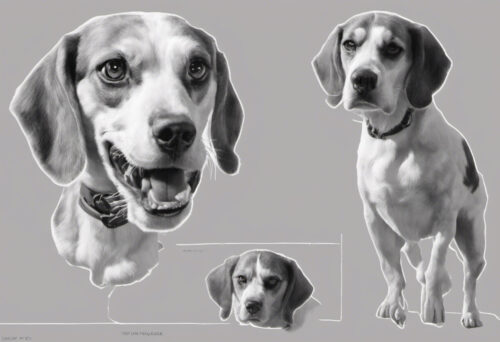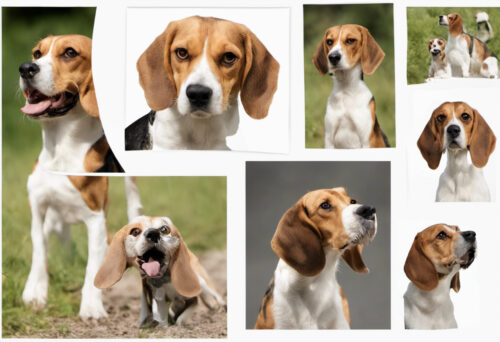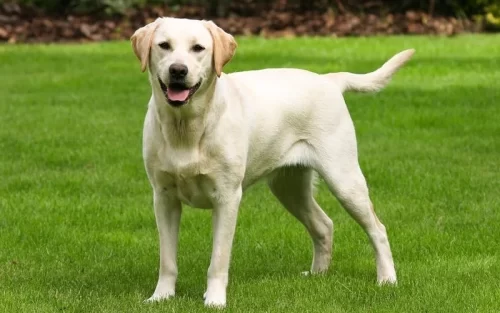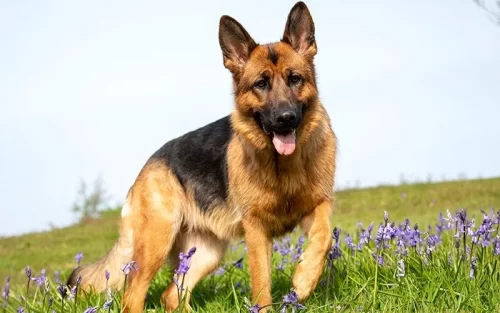Is your furry friend more than just a pet, but a member of your family? If you are a proud parent of a Beagle-Harrier, this guide is tailor-made just for you! We aim to deepen your bond with your four-legged friend by helping you understand their unique body language. Like humans, dogs also have an elaborate range of physical cues to communicate their feelings, needs, and desires. While generic canine signs are well-known, each breed, including the delightful Beagle-Harriers, has its unique expressions, and that’s the joy and challenge of decoding them.
A Primer on Beagle-Harrier Body Language
Beagle-Harriers, a rare breed with a rich history, demonstrate distinct physical behaviour. This mix between the popular Beagle and larger Harrier results in a medium-sized dog renowned for its hunting abilities and excellent sense of smell. These traits play into their communication style, making understanding their body language both fascinating and crucial for a harmonious relationship.
Ears and Eyes Tell a Tale
Beagle-Harriers, like their Beagle and Harrier parents, have large ears that noticeably move during different emotional states. Watch closely to understand what each subtle shift means. Whether it’s the curious forward tilt when they are intrigued or the flat lay against the head when fearful, each position signifies something. Here is a guide to understanding more about the language of dog’s ears. Similarly, their eyes speak volumes. Dilated pupils can indicate high arousal or anxiety, while ‘soft’ eyes often mean your canine companion is relaxed and content.
The Beagle-Harrier’s Tail End Theory
Many people mistakenly believe that a wagging tail is a universal dog sign for happiness – but this isn’t necessarily the case! A dog’s tail can wield a lot of emotional nuance. For Beagle-Harriers, a stiff, tail wagged high and swiftly might indicate alertness. Contrastingly, a low tail often signifies nervousness or submission. Minimum wagging typically implies discomfort or uncertainty. We advise reading this AKC’s guide to truly decode tail talk.
Remember, communication involves paying close attention to context. A bunch of physical cues together; the tell-tale eyes, ears, tail combine to provide a complete picture of your Beagle-Harrier’s emotions. Add to this, the unique vocalisation found in this particular breed, and you will find yourself having meaningful ‘dogversations’.

Mood Indicators in Beagle-Harriers
More than just being man’s best friend, dogs can also serve as barometers for mood. Their natural empathetic tendencies allow them to pick up on their owners’ feelings and respond empathetically. The Beagle-Harriers, with their keen senses and observant traits, do this remarkably well. Paying attention to their reactions can give you insight into your own mood as well. Remember, your feelings might impact your four-legged friend far more than you realise.
The Play Bow and Play Stance
Beagle-Harriers are a breezy, fun-loving breed. When excited and ready to play, they adopt a specific play stance with their front legs spread out, rear end up, and tail wagging energetically. This is known as the play bow, one of the delightful ways your pup tells you they want to have fun! This Dogster’s Guide can help you understand the play bow better.
Deciphering Barks and Whines
Canine communication goes beyond body language. Decoding the Beagle-Harrier breed’s barks, whines, and other vocalizations could turn you into a veritable ‘Dr. Dolittle’. And guess what, Beagle-Harriers are quite the vocal bunch. They come with an impressive vocal range owing to their hunting lineage. A sharp, short bark might indicate excitement. A constant, high-pitched whine could signal discomfort or distress. This ASPCA guide provides more insights into decoding dog sounds.
Observed Changes in Behavior
Sudden difficulties in communication or changes in behavior could be signs of a health issue. If your beagle-harrier appears to be struggling with expressing themselves as they usually would, it’s always wise to consult with a veterinarian. The American Veterinary Medical Association’s guide on pet behavior could aid you in recognising when something is amiss.
Interacting with your Beagle-Harrier, understanding their quirks, and responding appropriately will strengthen your bond with them more deeply than ever. By diving deep into the nuances of this breed’s communication, you will not only become a better parent to your beloved pet but also a capable dog communicator in a broader sense. So tune into their body language, be conscious of their vocalisations, and prepare yourself for an enriching journey of companionship.

Understanding Aggression and Fear
Sometimes, your furry friend’s body language might signal emotions of fear or aggression. Special caution is required to interpret these signs accurately and respond appropriately. Shaking or trembling, growling, bared teeth, or flattened ears indicate that the dog might be anxious, scared, or aggressive. Avoid approaching, touching, or making direct eye contact during such situations. Knowing how to react to aggression is vital to prevent accidentally escalating the situation. Refer to this Humane Society’s Guide to help you navigate through such scenarios.
Tools to Aid in Understanding Beagle-Harrier Body Language
The internet offers many valuable resources that aid in understanding the love language of these expressive, loving canines. Online platforms such as Reddit, and dog-centric websites like the Modern Dog Magazine, often feature articles and forums that delve deep into canine behaviour. YouTube channels like Zak George’s Dog Training Revolution offer practical tips and video demonstrations to further enhance your understanding.
The Power of Non-Verbal Communication
Your Beagle-Harrier not only tunes into your voiced commands and praises but also your body language. Dogs often mirror their owners’ feelings. That’s why maintaining a relaxed and confident demeanor in your interactions helps in forging a healthy, positive communication with your pet. This PetEducation’s guide provides insights into how dogs perceive human body language.
Conclusion: The Art of Understanding Your Beagle-Harrier
Deciphering your Beagle-Harrier’s body language is an art and a skill that will not only strengthen your bond but also enable you to address their needs effectively. Trust your instincts, observe their signals, and respond with empathy and patience. As you grow attuned to their unique language, you’ll come to realise a new depth to your companionship. Remember, patience, love, and consistency is key.
So, roll up your sleeves, observe your best bud, and embark on this enriching journey of understanding your Beagle-Harrier’s body language. This interaction is not a one-way street. Your furry pal is also keenly observing and learning from you. Together, you’ll form a bond that transcends barriers and languages, fulfilling the essence of being a proud Beagle-Harrier parent. Happy decoding!



